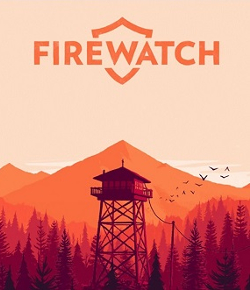Below I have included two components of a single post. The first is the markdown syntax of the text, followed by the output text. I use the indie game Firewatch as a platform to showcase both the impact of story telling on players, and the visual difference and clarity between markdown syntax and output text.
Markdown Text
#<center>Story Telling in Indie Games: Using Firewatch to Experience Mutuality with the Player Character</b></center>#
<center>![Firewatch Cover] (https://upload.wikimedia.org/wikipedia/en/a/a5/Firewatch_cover.jpg)
<sub>Firewatch Cover</sub></center>
###<b><big>Context</b></big>
>Set in 1989, the player assumes the role of Henry, a fire watcher, who uncovers a monumental story on his expeditions throughout the forest. The player becomes ultimately aware of Henry's singularity, as you are the only person you see, but do have contact with one other individual: Delilah. Peers within the context of fire watching the same national forest, Delilah becomes the primary point of conversation and contact within the context of the story. Not only are we made aware of Henry's loneliness, but we become prone to his contribution to a relationship forming within the context of the story. This relationship, though only for the purpose of propelling the story and contributing to the growing tension between the purpose of the game and the forefront fear of finding something eerily disturbing, forefronts the reality of Henry's summer job: he is alone. So very alone, in fact, that he never sees Delilah, despite their constant contact with one another over the course of the game.
###<b><big>Story Prevalence</b></big>
>The story contributes to the very purpose of this game. Without the story, the game would be another free roam exploration without purpose and rely primarily on player expedition. The player also becomes aware of this feeling of dread that permeates the story line. We, as individuals outside the reality of the game, start to feel alone and begin relating to Henry as a fictional character. We feel his singularity as a component of the game, and feel pressured into enduring the story while we watch idly as our main character succumbs to a singular relationship with a nonphysical conception of a human named Delilah. Yes, Delilah is a real person in terms of the game-verse, but Henry, nor the player, is shown her physicality. This only promotes the encroachment of Henry's singularity and loneliness as we proceed with the plot.
###<b><big>Experiencing Emotion with the Player Character</b></big>
<center>![Brian Goodwin] (https://vignette.wikia.nocookie.net/fire-watch/images/b/b5/450px-BrianGoodwin.png/revision/latest/scale-to-width-down/220?cb=20160314010458)</center><center> <sub>Brian Goodwin</sub></center>
>The player is acutely aware of the uneasiness within the game, as I touch briefly on prior. But we are not sure <i>why</i> we feel this way. What is uneasy within the context of the game to promote uninterpreted fear? As story-based games are not commonly played or widely spread within popular gaming culture, versus AAA games and MMO, action misadventures, the perception that a game is completely safe for the player character comes across as uneasy. We are aware of this as the player, and feel that a component of our experience is missing. This is the nature of story-based and narrative games. However, this feeling also contributes to the necessity to play the game, and reach a conclusive ending. We become obsessive with the game's message.
>Within <i>Firewatch</i>, the player experiences this feeling of uneasiness that seems to permeate the purpose of our interaction with the game. As the story unfolds, we are informed of an incident involving a young boy, Brian, who was the lookout for his father, Ned, a classified alcoholic. As the player, up to this point, has been made routinely aware of missing persons (such as the teenage girls gone missing prior to the boy Brian), we become uncertain of the circumstances we are walking into. The player becomes a component of the game, feeling the anxiety Henry is supposed to feel, becoming the physical for the digital world. We are instructed by Delilah to search for Brian, and upon entering the cave are suddenly locked in by an individual never showed or named. The conception of fear played within this part of the story stifles the beauty of the game for a moment and, instead, stirs up perceptions of reality that consummate this climatic moment. We are responsive to the context of the story, and have become impacted by the game. Understanding the severity of the situation, anxiety swells within the player as the story unfolds to Henry discovering the mummified body of Brian in the location he once used to hide from his father.
###<b><big>Why are We Impacted?</b></big>
>We are not directly impacted by this image and message of the game, but begin to realize that the aspect of loneliness that once permeated our interpretation of <i>Firewatch</i> was now replaced with the body of a dead boy. Not only this, but the end of the story is left with the need to escape a forest fire and saying goodbye to Delilah over the radio rather than in person. However, the credit do provide insight to the life of Brian before his death, and Henry, the player character. Now only does this provide more context to the story, but embeds emotional impact into the experience of the player.
>From being alone and accepting this with persistent conversation between Delilah and Henry, the player succumbs to the impact of the story. Yes, we are meant to experience the beauty of the scenery, and the expedition of being a fire watcher, but are ultimately saddened at the disheartening <i>goodbye</i> between Delilah and Henry as the final tick in separation anxiety and cabin fever. The realization that the only only figure we see within the story is the body of Brian gives context to the purpose of the game: the story exists for us to <i>live</i> it rather than <i>play</i> it.
<center>![Typewriter] (https://d1u5p3l4wpay3k.cloudfront.net/firewatch_gamepedia/thumb/5/53/Typewriter.jpg/534px-Typewriter.jpg?version=4067b4d1d4425e830d6e7d064369ee5e)<sub>
Henry's Typewriter</sub></center>
Output Text
Story Telling in Indie Games: Using Firewatch to Experience Mutuality with the Player Character

Firewatch Cover
Context
Set in 1989, the player assumes the role of Henry, a fire watcher, who uncovers a monumental story on his expeditions throughout the forest. The player becomes ultimately aware of Henry's singularity, as you are the only person you see, but do have contact with one other individual: Delilah. Peers within the context of fire watching the same national forest, Delilah becomes the primary point of conversation and contact within the context of the story. Not only are we made aware of Henry's loneliness, but we become prone to his contribution to a relationship forming within the context of the story. This relationship, though only for the purpose of propelling the story and contributing to the growing tension between the purpose of the game and the forefront fear of finding something eerily disturbing, forefronts the reality of Henry's summer job: he is alone. So very alone, in fact, that he never sees Delilah, despite their constant contact with one another over the course of the game.
Story Prevalence
The story contributes to the very purpose of this game. Without the story, the game would be another free roam exploration without purpose and rely primarily on player expedition. The player also becomes aware of this feeling of dread that permeates the story line. We, as individuals outside the reality of the game, start to feel alone and begin relating to Henry as a fictional character. We feel his singularity as a component of the game, and feel pressured into enduring the story while we watch idly as our main character succumbs to a singular relationship with a nonphysical conception of a human named Delilah. Yes, Delilah is a real person in terms of the game-verse, but Henry, nor the player, is shown her physicality. This only promotes the encroachment of Henry's singularity and loneliness as we proceed with the plot.
Experiencing Emotion with the Player Character

The player is acutely aware of the uneasiness within the game, as I touch briefly on prior. But we are not sure why we feel this way. What is uneasy within the context of the game to promote uninterpreted fear? As story-based games are not commonly played or widely spread within popular gaming culture, versus AAA games and MMO, action misadventures, the perception that a game is completely safe for the player character comes across as uneasy. We are aware of this as the player, and feel that a component of our experience is missing. This is the nature of story-based and narrative games. However, this feeling also contributes to the necessity to play the game, and reach a conclusive ending. We become obsessive with the game's message.
Within Firewatch, the player experiences this feeling of uneasiness that seems to permeate the purpose of our interaction with the game. As the story unfolds, we are informed of an incident involving a young boy, Brian, who was the lookout for his father, Ned, a classified alcoholic. As the player, up to this point, has been made routinely aware of missing persons (such as the teenage girls gone missing prior to the boy Brian), we become uncertain of the circumstances we are walking into. The player becomes a component of the game, feeling the anxiety Henry is supposed to feel, becoming the physical for the digital world. We are instructed by Delilah to search for Brian, and upon entering the cave are suddenly locked in by an individual never showed or named. The conception of fear played within this part of the story stifles the beauty of the game for a moment and, instead, stirs up perceptions of reality that consummate this climatic moment. We are responsive to the context of the story, and have become impacted by the game. Understanding the severity of the situation, anxiety swells within the player as the story unfolds to Henry discovering the mummified body of Brian in the location he once used to hide from his father.
Why are We Impacted?
We are not directly impacted by this image and message of the game, but begin to realize that the aspect of loneliness that once permeated our interpretation of Firewatch was now replaced with the body of a dead boy. Not only this, but the end of the story is left with the need to escape a forest fire and saying goodbye to Delilah over the radio rather than in person. However, the credit do provide insight to the life of Brian before his death, and Henry, the player character. Now only does this provide more context to the story, but embeds emotional impact into the experience of the player.
From being alone and accepting this with persistent conversation between Delilah and Henry, the player succumbs to the impact of the story. Yes, we are meant to experience the beauty of the scenery, and the expedition of being a fire watcher, but are ultimately saddened at the disheartening goodbye between Delilah and Henry as the final tick in separation anxiety and cabin fever. The realization that the only only figure we see within the story is the body of Brian gives context to the purpose of the game: the story exists for us to live it rather than play it.

Henry's Typewriter
